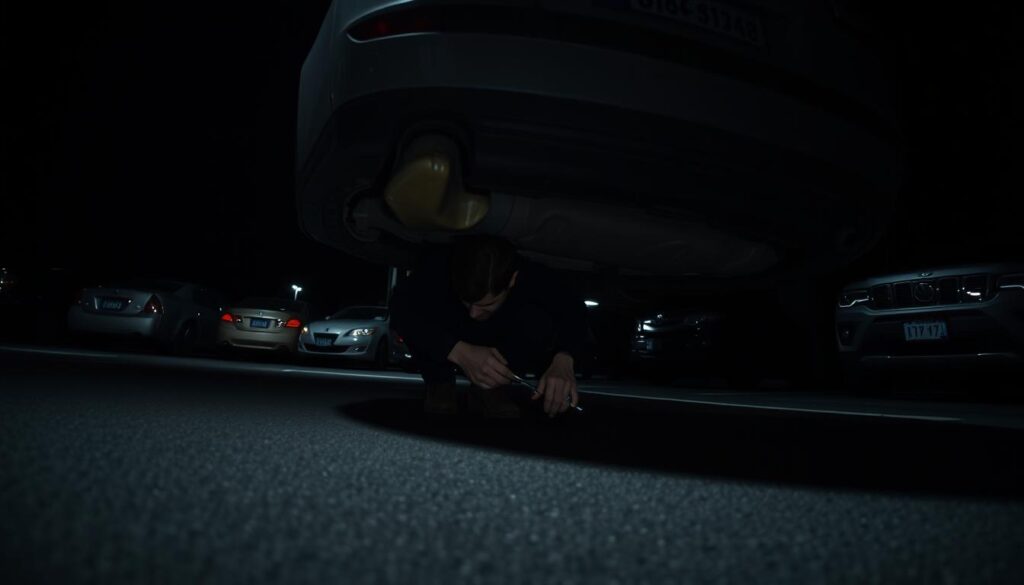Each year, criminals illegally access over 125,000 vehicles in Canada. These crimes result in property losses exceeding $85 million. Understanding unlawful entry laws is crucial for all Canadian vehicle owners.
The Criminal Code of Canada addresses these offenses under Section 348. It criminalizes unauthorized access to various places, including automobiles. Entering a car without permission to commit a crime has serious legal consequences.
Section 351 makes it illegal to possess tools for breaking into vehicles. This law aims to protect your property from unauthorized intrusion.
Knowing these regulations provides essential information for vehicle owners. It’s useful whether you’re protecting your car or dealing with a potential case.
The following sections will explore specific elements of these laws. We’ll also discuss possible defenses and penalties for violations.
Understanding Break and Enter a Motor Vehicle in Canadian Law
Vehicle break-in laws in Canada are complex. The Criminal Code defines these offenses uniquely. Auto burglary has specific legal consequences that reflect its seriousness.
Canadian law treats unauthorized vehicle entry as a protected “place”. This affects how car break-in cases are prosecuted and penalized.
Vehicle crime rates vary across regions. Some areas have higher automobile crimes in Canada’s most affected cities. Understanding the legal framework is crucial for prevention and response.
Legal Definition Under the Criminal Code
Section 348 of the Criminal Code defines breaking and entering. It includes entering a place to commit an offense or breaking out after committing one.
This section protects “railway vehicles, vessels, aircraft, or trailers”. Motor vehicles have the same legal protection as buildings against unauthorized entry.
Historical Development of the Law
Vehicle trespass laws have changed over time. Early Canadian law focused on protecting dwellings and fixed structures.
As cars became common, laws expanded to protect vehicles. This change recognized the value of cars and their contents.
Current Legal Framework
Section 348 now treats motor vehicles as protected spaces. Prosecutors must prove certain elements for a car break-in charge.
- An actual breaking or entry into the vehicle
- The absence of consent from the rightful owner
- Intent to commit an indictable offense inside the vehicle
Charges can vary based on circumstances and timing. Penalties range from summary to indictable offenses.
Distinction from Other Property Crimes
Vehicle break-ins differ from other property crimes. These differences affect how cases are charged and prosecuted.
Theft vs. Break and Enter
Theft involves taking property without permission. Auto burglary requires unauthorized entry into the vehicle.
Stealing from an unlocked car might lead to theft charges. Forcing entry could result in breaking and entering charges.
Mischief vs. Break and Enter
Mischief applies to property damage without intent to steal. The key difference is the intent behind the action.
Breaking a car window for damage is mischief. Breaking it to steal items inside is breaking and entering.
These legal distinctions impact court proceedings. They can significantly affect sentencing outcomes for automobile crimes.
The Criminal Code of Canada and Vehicle Break-ins
Canadian law tackles vehicle break-ins through the Criminal Code. It sets clear rules for prosecuting these crimes. These laws define break and enter offenses involving motor vehicles.
The Code recognizes the impact ofsmash and grabincidents on victims. These crimes cause property loss and leave people feeling unsafe. Laws have evolved to address changing patterns in vehicle-related property crimes.
Section 348 of the Criminal Code
Section 348 is the main law for prosecutingbreak and enter a motor vehicleoffenses. It defines the crime and sets penalties. The broad definition of “place” includes various types of motor vehicles.

Section 348(3) defines “place” to include railway vehicles, vessels, aircraft, and trailers. This definition applies to standard motor vehicles too. Section 351 mentions “motor vehicle” regarding possession of break-in tools.
The Code treats different vehicle types and scenarios uniquely. Breaking into a commercial vehicle may differ from entering a personal one. The law also covers break-ins for vandalism or seeking shelter.
Interpretation by Courts
Canadian courts have shaped how Section 348 applies to vehicle break-ins. They’ve clarified ambiguities and set precedents for prosecuting these cases. Courts rule that breaking into a vehicle with criminal intent is a break and enter.
Judges have defined what “breaking” means for vehicles. Entering through an unlocked door is “entering” but not “breaking”. This distinction can affect the charges laid.
Related Provisions and Statutes
Provincial and municipal laws complement federal legislation onstealing from vehicles. This creates a comprehensive legal framework that varies across Canada. It addresses vehicle break-ins and related offenses effectively.
Provincial Highway Traffic Acts
These acts contain rules about vehicle security. They require drivers to secure vehicles when parked. Some provinces mandate removing keys and locking doors in public places.
These laws affect howtheft from autocases are handled. They may establish reporting requirements for break-ins. This impacts insurance claims and crime tracking across jurisdictions.
Municipal Bylaws
Many cities have bylaws addressing vehicle security. These might include parking lot regulations or security measures in high-crime areas. They may set penalties for minor vehicle break-in offenses.
Local officers often work with police on vehicle break-in patterns. These bylaws provide tools for addressing security concerns locally. They complement the Criminal Code and provincial laws.
“The interplay between federal criminal law, provincial regulations, and municipal bylaws creates a complex but comprehensive approach to addressing vehicle break-ins across Canada. This multi-layered legal framework reflects the seriousness with which our legal system treats these property crimes.”
Elements of Break and Enter a Motor Vehicle Offenses
Vehicle break-in offenses involve complex physical actions and mental states under Canadian law. Prosecutors must prove several key elements beyond reasonable doubt. This knowledge is vital for those facing charges or protecting their property.
The Act of Breaking and Entering
Vehicle break-in offenses involve two distinct actions: breaking and entering. These elements have specific legal definitions that differ from common understanding.
What Constitutes “Breaking”
Section 321 of the Criminal Code defines “breaking” as damaging any part of a vehicle. It includes opening anything used to close or cover an opening.
This covers various methods of unlawful entry into vehicles. Examples include forcing locks, breaking windows, and bypassing security systems.
Even minimal force can satisfy the breaking requirement. Courts have ruled that pulling an unlocked door handle counts as breaking.
What Constitutes “Entering”
Section 350 defines “entering” as any body part or instrument within the entered object. Vehicle trespass can occur without full bodily entry into the vehicle.
Reaching through a broken window or using a tool to unlock doors qualifies. Partial entry is enough to satisfy this element of the offense.

Intent Requirements
Prosecutors must also establish the mental elements of a car break-in offense. Intent requirements are complex and often central to legal defenses.
General vs. Specific Intent
Break and enter offenses involving motor vehicles require specific intent. Prosecutors must prove you knowingly broke in and intended to commit an indictable offense inside.
Section 348(2) creates important presumptions about intent. Evidence of breaking and entering is considered proof of intent to commit an offense.
Proving Intent in Court
Prosecutors use various evidence to establish intent in automobile crimes cases. This includes possession of break-in tools, theft of items, and statements by the accused.
Courts examine all circumstances to determine if specific intent is met. Your actions before and after the alleged break-in can impact how intent is interpreted.
What Constitutes a “Motor Vehicle”
The final element concerns which vehicles are protected under break and enter laws. This definition has expanded to include various forms of transportation.
Legal Definitions
The Criminal Code doesn’t explicitly define “motor vehicle” for break and enter offenses. However, Section 348(3) includes railway vehicles, vessels, aircraft, and trailers.
Generally, a motor vehicle is any self-propelled vehicle designed for transportation on public roads. This excludes vehicles that run on rails.
Types of Vehicles Covered
Break and enter laws protect a wide range of vehicles from stealing from vehicles offenses. This includes cars, trucks, RVs, construction equipment, and certain watercraft.
Courts take a broad approach to what constitutes a vehicle under these provisions. Even non-operational vehicles may qualify if they maintain essential motor vehicle characteristics.
Understanding these elements is crucial if you face vehicle break-in charges. It’s also important for those seeking to protect their property from such crimes.
Types of Break and Enter a Motor Vehicle Scenarios
In Canada, motor vehicle break-ins fall into several categories. These categories affect how crimes are prosecuted. Law enforcement tracks car break-in patterns to improve prevention strategies.
Understanding these scenarios helps the public and legal professionals recognize different offenses. This knowledge aids in developing better protection measures against vehicle-related crimes.
Theft from Vehicles
Theft is the main reason for vehicle break-ins. It makes up about 85% of reported auto burglary cases in Canada. The stolen items often determine the entry method and legal consequences.
Personal Property Theft
Criminals target visible valuables left inside vehicles. Common items include electronics, purses, wallets, and shopping bags. Thieves look for quick opportunities, breaking into cars with clearly visible valuables.
Courts consider the value of stolen items when sentencing. Stealing a laptop with sensitive business data may lead to harsher penalties than taking low-value items.
Vehicle Part Theft
A rising trend involves stealing valuable vehicle components. Catalytic converters are prime targets due to their precious metal content. Other commonly stolen parts include airbags, navigation systems, and luxury vehicle headlights.
- Airbags
- Navigation systems
- Headlights (particularly from luxury vehicles)
- Tailgates from pickup trucks

Vandalism and Damage During Entry
The methods used to enter vehicles are important legal elements. Damage caused during entry often results in additional charges beyond theft. These factors influence how cases are handled in court.
Smash and Grab Incidents
The most direct entry method involves breaking a window for quick access. These smash and grab incidents typically take less than 60 seconds. The thief breaks the window, grabs visible valuables, and flees.
Courts consider both theft and property damage when determining penalties. Areas with frequent smash and grab incidents may see tougher enforcement and harsher sentences.
Electronic Bypass Methods
Modern vehicles face sophisticated threats beyond physical force. Electronic methods to bypass security systems are becoming more common. These high-tech approaches often leave minimal physical evidence.
- Signal amplifiers that extend the range of keyless entry fobs
- Code grabbers that capture and replicate remote signals
- OBD port manipulation devices that override vehicle security
These methods are considered aggravating factors in sentencing due to their premeditated nature. Law enforcement agencies are adapting their techniques to address these evolving car break-in crimes.
Penalties for Break and Enter a Motor Vehicle in Canada
Breaking into a vehicle in Canada carries hefty legal penalties. The justice system takes these property crimes seriously. The Canadian Criminal Code sets specific punishments for vehicle break-ins.
Penalties vary based on the offense’s circumstances and prosecution choices. Understanding these potential consequences is vital if you’re facing charges. It’s also helpful for those wanting to know about legal ramifications of automobile crimes.
Summary vs. Indictable Offenses
Canadian law classifies crimes as summary or indictable offenses. This is similar to misdemeanors and felonies in other countries. For break and enter a motor vehicle cases, this classification greatly affects potential penalties.
Maximum Penalties
Section 348(1)(e) of the Criminal Code covers breaking into non-dwelling places, including vehicles. As an indictable offense, it carries up to ten years in prison. This reflects the serious impact of vehicle trespass on victims and communities.
Summary conviction offenses have less severe but still significant penalties. You could face up to two years less a day in jail, a hefty fine, or both. Even a summary offense conviction results in a criminal record.
This record can affect your future employment, travel, and other opportunities. It’s a lasting consequence of breaking into a vehicle.
Hybrid Offenses
Many unlawful entry offenses related to vehicles are hybrid offenses in Canada. Prosecutors can choose to proceed by summary conviction or indictment. Their decision typically depends on several factors.
These factors include the offense’s severity, use of violence, value of stolen or damaged items, and your criminal history. The overall public interest in the case also plays a role.
This flexibility allows the justice system to tailor its response to each case. More serious cases are usually prosecuted by indictment. Less severe incidents may proceed by summary conviction.

| Classification | Maximum Penalty | Procedural Implications | Typical Scenarios |
|---|---|---|---|
| Indictable Offense | Up to 10 years imprisonment | Jury trial option, longer limitation periods | Organized theft rings, significant damage, theft of valuable items |
| Summary Offense | Up to 2 years less a day imprisonment | Simpler proceedings, shorter limitation periods | Opportunistic break-ins, minimal damage, lower value items taken |
| Hybrid Offense | Depends on election | Prosecutor chooses the path | Most vehicle break-ins fall here, allowing case-by-case assessment |
Sentencing Guidelines and Factors
Canadian courts consider many factors when sentencing break and enter a motor vehicle convictions. The process aims to balance punishment, deterrence, rehabilitation, and societal protection. It goes beyond the basic offense classification.
Judicial Discretion
Canadian judges have significant discretion when sentencing vehicle break-in offenders. They must consider principles outlined in Section 718 of the Criminal Code. These include denouncing unlawful conduct and deterring criminal behavior.
Separating offenders from society when necessary is another consideration. Promoting a sense of responsibility in offenders is also important.
Several specific factors influence sentencing decisions in vehicle break-in cases. These include your prior criminal record and whether the crime seemed planned or opportunistic.
The time of day matters too, with nighttime break-ins often treated more severely. The presence of accomplices or links to organized crime are also considered.
Impact Statements and Considerations
Victim impact statements are crucial in sentencing for automobile crimes. They help judges understand how the crime affected the victim beyond monetary losses. For vehicle break-ins, these statements often highlight significant life disruptions.
Losing essential work tools, important documents, or irreplaceable personal items can be devastating. Many victims report feeling violated and unsafe, especially when the crime occurred at home.
Courts also consider the broader impact of vehicle trespass on communities. Areas with high break-in rates often see increased insurance premiums and reduced property values. Residents may feel less secure.
These community impacts may factor into sentencing, especially for repeat offenders or crime sprees. The goal is to address both individual and societal harm caused by vehicle break-ins.
Aggravating Factors in Vehicle Break-in Cases
Car break-ins vary in severity under Canadian law. Certain elements can turn a basic property crime into a serious offense. Courts may impose harsher penalties when aggravating circumstances are present.
Understanding these factors is vital if you face charges or want to protect yourself. Knowing the law can help you navigate the legal system more effectively.
Use of Weapons or Violence
A simple smash and grab becomes more serious with weapons or violence. If someone breaks into your car, their response can change the charges they face.
Weapons during a break-in signal a higher risk to public safety. Canadian courts see this as an escalation from property crime to a dangerous offense.

With weapons or violence, sentencing guidelines change dramatically. Judges may impose penalties closer to the maximum under Section 348 of the Criminal Code. Typical sentences for aggravated cases usually range from 2-10 years.
Courts consider the weapon type and extent of violence or threats. A firearm triggers mandatory minimum sentences under Canadian law. This limits the judge’s sentencing discretion.
Additional Charges
Weapons or violence often lead to multiple charges. These may include assault with a weapon, uttering threats, and weapons possession offenses. Robbery charges apply if force was used to take property.
These charges are often prosecuted together. You could face separate penalties for each offense. This increases the consequences of what started as stealing from vehicles.
Prior Criminal History
Your past can impact how the legal system responds to a vehicle break-in charge. Prior convictions, especially for similar crimes, typically result in harsher sentences.
Canadian courts believe repeat offenses show failed rehabilitation. Judges review criminal records to determine appropriate sentencing for car break-ins.
Repeat Offenders
Previous property crime convictions lead to harsher penalties with each new conviction. Courts worry about patterns showing a focus on certain types of crime.
Repeat auto burglary offenders may face maximum sentences. Courts may also order probation conditions like curfews or restrictions on being near parking facilities.
Criminal Organization Involvement
Vehicle break-ins linked to organized crime get special attention. When stealing from vehicles is part of a larger operation, legal consequences escalate significantly.
Evidence of coordination or sophisticated methods can lead to additional charges. These may include participation in a criminal organization under Section 467.11 of the Criminal Code.
Courts view organized vehicle theft as particularly harmful due to its systematic nature. Links to larger networks could mean enhanced penalties and more prosecution resources.
Legal Defenses Against Break and Enter Charges
Facing break and enter charges for vehicle trespass? Understanding legal defenses can greatly impact your case outcome. Canadian courts recognize specific strategies to challenge unlawful entry allegations. Your defense team can use these approaches to contest the prosecution’s case.
Effective strategies can make or break cases involving automobile crimes. The prosecution must prove all offense elements beyond doubt. This gives your defense team various opportunities to challenge the Crown’s case.
Consent and Authorization
A strong defense against vehicle break-in charges is proving you had permission. This negates the “without lawful justification” element required for conviction. It directly challenges a key part of the Criminal Code.
Express Permission
Express permission means the owner clearly allowed you to enter the vehicle. For example, you’re a mechanic with documented repair authorization. Or a friend asked you to get items from their car.
Courts look for evidence like text messages, witness statements, or business relationships. The more formal and documented the permission, the stronger your defense becomes.
Implied Permission
Implied permission is less direct but still valid. It occurs when past behavior suggests you had authorization to enter. For instance, you regularly borrow your roommate’s car without asking each time.
This defense can be harder to prove. It often requires testimony about relationship dynamics and vehicle access patterns. Success depends on showing you reasonably believed you had permission.

Mistaken Identity
Many theft from auto cases rely on identification evidence. This evidence can be challenged. Mistaken identity is a powerful defense, especially when the perpetrator was briefly seen.
Alibi Evidence
An alibi defense proves you were elsewhere during the break-in. Strong alibis typically include video footage, electronic records, or credible witness testimony. Work records or attendance logs can also help.
Canadian courts require advance disclosure of alibi evidence to the prosecution. The more verifiable and objective your evidence, the stronger your defense becomes.
Challenging Identification
You can question evidence linking you to the incident. This might involve challenging eyewitness reliability or surveillance footage quality. You can also contest proper handling of fingerprints or DNA evidence.
Expert testimony can highlight limitations of eyewitness identification. It can also reveal flaws in forensic evidence collection that led to wrongful identification.
Lack of Intent
Break and enter charges require proof of intent to commit an indictable offense. Challenging this intent element can form a strong defense strategy.
Necessity
In rare cases, breaking into a vehicle may be legally justified by necessity. This applies when you faced imminent harm and had no reasonable alternative. The prevented harm must outweigh the harm of breaking in.
Examples include rescuing a child from extreme weather. Or accessing life-saving medication during an emergency. Courts apply this defense narrowly, requiring strong evidence of true necessity.
Intoxication Defenses
Voluntary intoxication rarely succeeds as a defense for vehicle break-ins. However, extreme intoxication preventing specific intent may apply in certain cases. The Supreme Court recently revisited laws on extreme intoxication defenses.
This defense typically needs expert testimony. It must prove you couldn’t understand your actions’ nature or consequences. This high threshold applies only in exceptional circumstances.
Your Rights if Charged with Break and Enter a Motor Vehicle
Knowing your legal rights is crucial if charged with breaking into a vehicle in Canada. The justice system offers protections for those accused of automobile crimes. These rights help you navigate the legal process and make informed decisions.
When facing car break-in charges, you have specific legal protections. These safeguard your interests from arrest through trial. These rights are fundamental to Canada’s criminal justice system.
Right to Legal Representation
Access to legal counsel is a key right when charged with vehicle break-in. The Canadian Charter guarantees your right to consult a lawyer upon arrest. Police must inform you of this right before questioning.

Legal aid is available if you can’t afford a private attorney for your auto burglary case. Each province has its own program with different eligibility requirements. These are based on income and charge severity.
| Province | Income Threshold | Coverage for Break and Enter | Application Process |
|---|---|---|---|
| Ontario | $17,731 (single person) | Full coverage | Online or in-person application |
| British Columbia | $19,560 (single person) | Full coverage | Phone assessment required |
| Alberta | $20,021 (single person) | Full coverage | Online application available |
| Quebec | $23,842 (single person) | Full coverage | In-person at legal aid bureau |
Duty Counsel
Duty counsel lawyers are available at most courthouses if you lack representation. They can assist with first appearances and bail hearings. They also provide basic legal advice for theft from auto charges.
Duty counsel services are free regardless of income. However, they’re limited in scope. They can’t replace dedicated legal representation throughout your case.
Protection Against Unreasonable Search and Seizure
The Charter protects you from unreasonable search and seizure by law enforcement. This is crucial in car break-in cases, where evidence collection methods may be questioned.
Charter Rights
Police need reasonable grounds to search your vehicle, home, or belongings. Searches without warrants or proper justification may violate your Charter rights. This applies to vehicle searches, electronic device seizures, and consent-related issues.
Exclusion of Evidence
You can request evidence exclusion if obtained through a Charter violation. Courts consider three factors when deciding to exclude evidence:
- The seriousness of the Charter-infringing conduct
- The impact of the breach on your Charter-protected interests
- Society’s interest in the adjudication of the case on its merits
Excluding key evidence can weaken the prosecution’s case against you in vehicle break-in charges.
The Bail Process
After arrest for break and enter a motor vehicle, you’ll face a bail hearing. A judge decides if you should be released before trial. Understanding this process is vital for securing pre-trial freedom.
Conditions of Release
If granted bail, you’ll likely face specific conditions. These address public safety concerns and ensure court attendance. Common conditions include:
- Regular reporting to police
- Curfews or house arrest
- Prohibitions on possessing break-in tools
- Restrictions on visiting certain areas (like parking lots or car dealerships)
- No contact with alleged victims or co-accused
Violating these conditions can lead to more charges and bail revocation. For serious automobile crimes, the Crown may seek detention instead of release.
Surety Requirements
The court may require a surety to supervise you on bail. This person pledges money as a guarantee. They vouch for your behavior and report any bail violations.
Surety amounts vary based on charge severity and criminal history. For first-time theft from auto offenders, amounts range from $1,000 to $5,000. Repeat offenders may face higher requirements.
Provincial Variations in Break and Enter Laws
Canada’s provinces handle vehicle break-ins differently, despite a shared federal Criminal Code. Section 348 of the Criminal Code defines these laws nationally. However, their application varies across regions.
These differences matter if you’re facing charges or want to protect your vehicle. Each province’s approach to justice creates a unique landscape for handling these crimes.
Enforcement Differences Across Provinces
Provinces tackle vehicle trespass offenses based on local needs and crime patterns. British Columbia’s Vancouver Police Department has special units for tourist areas. Alberta focuses on rural property crime, including vehicle theft and break-ins.
Ontario and Quebec put more resources into urban centers with high smash-and-grab rates. Atlantic provinces often use community-based prevention strategies due to limited resources.
These differences affect how thoroughly cases are investigated and how quickly they’re resolved. They also impact prosecution rates for similar offenses across provinces.
Urban vs. Rural Approaches
Cities and rural areas handle car break-ins differently. Urban police use data to target hot spots and often employ surveillance tech and bait cars.
Rural detachments cover larger areas with fewer officers. They focus on prevention through community awareness programs. Response times vary greatly between urban and rural areas.

Some provinces have special task forces for vehicle crimes. The Integrated Municipal Provincial Auto Crime Team (IMPACT) in BC tackles auto theft and break-ins across cities.
Ontario’s Provincial Auto Theft and Property Crime Unit fights organized vehicle crime networks. These units often solve complex cases better than regular patrols.
They’re experts at spotting entry techniques and linking isolated incidents to larger criminal operations.
Local Court Practices
Courts handle vehicle break-in cases differently across provinces. Quebec processes these cases faster than the Northwest Territories or Nunavut. In these territories, courts must travel to remote communities.
Sentencing also varies. Urban courts with high break-in rates may give stricter penalties. Courts in low-crime areas might focus more on rehabilitation, especially for first offenses.
Diversion Programs
Many provinces offer alternatives for certain offenders, especially first-timers or youth. BC’s Alternative Measures Program helps eligible people avoid criminal records through community service and counseling.
Ontario’s Direct Accountability Program provides similar options for minor property crimes. Alberta and Saskatchewan use restorative justice to bring offenders and victims together.
These programs generally reduce repeat offenses compared to traditional sentencing for minor property crimes.
Specialized Courts
Some provinces have special courts that may handle vehicle break-ins. Mental health courts in Ontario, BC, and Nova Scotia help when mental illness contributes to crime.
Indigenous courts in BC and Saskatchewan use cultural practices to address cases involving Indigenous offenders. Drug treatment courts across Canada offer supervision when substance abuse drives property crime.
Notable Case Examples and Precedents
Court rulings have shaped Canada’s legal landscape for break and enter vehicle offenses. These decisions guide how laws are applied in real cases. They offer insights into how courts handle vehicle break-in cases.
Landmark Supreme Court Decisions
The Supreme Court of Canada has issued key rulings on break and enter laws for vehicles. These decisions clarify legal terms and set tests for lower courts to follow.
Cases Defining “Break and Enter”
The 1977 case R v Johnson is a major influence in this area. It established “constructive breaking,” where entry by threat or fraud counts as breaking and entering.
The Court ruled that using deception to enter a vehicle counts as “breaking.” This expanded break and enter charges beyond physical damage to locks or windows.
In R v Silveira (1995), the Court defined entry as complete when any part of the offender enters the vehicle. This helps prosecutors pinpoint when the crime occurs.

Several key decisions have addressed what counts as a “motor vehicle” for these charges. R v MacDonald (2002) ruled that temporarily immobile vehicles still qualify for protection.
This case focused on the vehicle’s intended purpose, not its current state. The 2008 case R v Bellegarde extended this to include partially assembled vehicles in storage.
Recent Significant Cases
Modern court decisions reflect new criminal techniques and changing societal views. Recent cases have tackled new auto burglary methods and shown shifts in sentencing attitudes.
Technological Considerations
As vehicle security improves, so do criminals’ methods. R v Djurovic (2017) addressed electronic vehicle entry for the first time.
The Court ruled that using signal amplifiers to capture key fob signals counts as “breaking.” This adapts the law to modern tech realities.
R v Fearon (2014) established privacy protections for cell phones found during vehicle break-in arrests. This affects how evidence from these cases can be used.
Sentencing Trends
Courts now take a more nuanced approach to sentencing for vehicle break-ins. R v Parranto (2021) emphasized proportionality in sentencing, influencing auto burglary penalties.
Factors like addiction, mental health, and Indigenous background are now considered. However, repeat offenders and organized theft ring members face harsher penalties.
R v Sharma (2019) stressed rehabilitation for first-time offenders. It also acknowledged the need for deterrence in high auto burglary areas.
| Case Name | Year | Key Principle Established | Impact on Vehicle Break-in Cases |
|---|---|---|---|
| R v Johnson | 1977 | Constructive breaking concept | Entry by deception qualifies as breaking |
| R v MacDonald | 2002 | Vehicle classification | Non-operational vehicles still protected |
| R v Djurovic | 2017 | Electronic entry methods | Technology-assisted entry constitutes breaking |
| R v Sharma | 2019 | Sentencing principles | Rehabilitation focus for first-time offenders |
Conclusion
Break and enter offenses for motor vehicles have serious legal consequences in Canada. The Criminal Code Section 348 guides prosecuting these crimes. Penalties range from summary convictions to indictable offenses, depending on circumstances and intent.
Understanding what prosecutors must prove is crucial when facing automobile crime charges. Courts examine if there was breaking and entering, the intent, and if the target qualifies as a motor vehicle.
Provincial differences affect how these cases move through the justice system. Local legal expertise is valuable if you’re charged with such an offense.
If accused of vehicle trespass, remember your rights to legal representation. You’re also protected against unreasonable search and seizure. Potential defenses may include consent, mistaken identity, or lack of intent.
Canadian courts balance property protection with appropriate justice responses. They consider rehabilitation potential and circumstances when determining sentences for automobile crimes.
Staying informed about break and enter laws for motor vehicles helps protect your interests. This knowledge is useful for vehicle owners and those facing charges alike.

